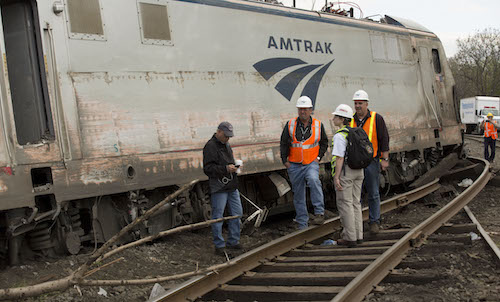Rail infrastructure between Washington and New York has been suffering for decades, falling victim to heavy traffic combined with a lack of investment. But federal regulators have a plan for sorely-needed upgrades that could shorten commutes and lead to IBEW jobs.

|
A 2015 speed-related crash on a curved section of track north of Philadelphia killed eight and injured more than 200. Amtrak’s plans call for straightening sharp curves to allow for faster travel.
Photo courtesy National Transportation Safety Board.
|
The $120 billion proposal released in December by the Federal Railroad Administration calls for repairs and replacement of long-neglected bridges and tunnels along with realigning portions of track where curves limit speed. Officials hope both moves, along with minor service expansions to parts of Connecticut, Rhode Island and Massachusetts, would relieve the Northeast Corridor of dozens of bottlenecks that slow down traffic on Amtrak’s busiest route.
On the heels of four years of study by Amtrak, state and local governments and eight commuter rail systems that would be affected, the final rail plan is expected to take 30 years to put into action if adopted in its entirety. FRA officials expect full implementation would reduce Washington to New York travel times by 35 minutes and New York to Boston travel times by 45 minutes, providing a significant economic boost to the rapidly-growing region.
IBEW Railroad Department Director Bill Bohne welcomed the news with cautious optimism, but he warned that the path between putting forward a plan and actually breaking ground on new projects can be long and complicated, with the likely end result being some sort of compromise.
“We’re 100 percent on board with what the FRA wants to do in the Northeast Corridor,” he said. “It’s work that needs to be done, and the bridge and tunnel projects especially could put a lot of our construction members to work. So much of this critical infrastructure is falling apart. Tunnels are leaking. It’s important investment, especially to the 2,500 IBEW members working every day on the Northeast Corridor at Amtrak and commuter railroads.”
The bulk of the IBEW’s Northeast Corridor railroad members work either on locomotives, passenger and commuter cars or on maintaining transmission lines north of New York City, so the project would impact many of them working for Amtrak and commuter systems like the Maryland Transit Authority in the Baltimore-Washington area, Metro North in New York and Connecticut, Southeastern Pennsylvania Transportation Authority in Philadelphia or New Jersey Transit. All of those systems share tracks with Amtrak, so this investment would improve rail travel and could lead to increases in ridership.
In announcing the FRA’s proposal for revitalizing the corridor that carried nearly 18 million Amtrak passengers in 2015, outgoing U.S. Transportation Secretary Anthony Foxx acknowledged the difficulty of getting any plan all the way to the construction phase.
“The Department of Transportation believes that investing in this vision for the Northeast Corridor must happen,” he said. “While building this recommendation would require significant investment, the cost of doing nothing is much greater.”
That cost could soar in the decades to come. The Northeast region accounts for nearly a third of all employment in the U.S. and nearly 20 percent of gross domestic product. With as many as 7 million new people expected in the region by 2040, any further degrading of the commuter infrastructure could seriously harm the nation’s economy. Sen. Cory Booker of New Jersey, whose state sends 400,000 people per day across the Hudson River to work in New York, says the condition of his region’s railways is “choking growth and productivity.”
At night, many of the same tracks are used by freight rail, which accounted for $274 billion in economic activity in 2014 and supported 1.5 million jobs, according to industry analysts.
On paper, the rail investment strategy seems to fit with President Donald Trump’s campaign promise of $1 trillion in infrastructure spending, one of the new administration’s policy proposals on which Democrats in Congress have signaled they could work together. But Republican leaders on Capitol Hill and in the White House have indicated that plans to repeal the Affordable Care Act and to reform the tax code in favor of business and the super-wealthy will take priority.
Also concerning is Trump’s pick to lead the Department of Transportation, which oversees the FRA. Elaine Chao, who led the Department of Labor for eight years under President George W. Bush, has long sided with big business over working people, highlighted by her department’s reluctance to investigate allegations of wage theft by employers during her tenure.
Some worry that even if there is a massive infusion of cash into railway building projects, congressional Republicans have long desired to end Davis-Bacon prevailing wage protections and to eliminate project labor agreements, both of which could become a reality in 2017. Without support at DOT, it becomes increasingly likely that union labor may not factor into the proposed upgrades, which would certainly create thousands of construction jobs.
“We’re glad federal regulators have proposed this ambitious strategy to upgrade our nation’s decaying rail infrastructure,” said International President Lonnie R. Stephenson, “but using our nation’s best-trained, most reliable union professionals to build it has to be a part of the equation if we expect the upgrades to last for the generations that come after us.”
While not technically included in the $120 billion proposal, the FRA indicated that its long-term strategy would work in conjunction with Amtrak’s Gateway project, currently in late planning stages, that would replace 108-year-old tunnels and bridges connecting New Jersey with Manhattan. That endeavor, projected to cost upwards of $25 billion, is on track for a decision from the federal government in early 2018 with final design and construction to follow.
Elected officials and business leaders from across the Northeast have encouraged Trump to embrace the new rail proposals and to keep the Gateway Project on track as his administration explores future infrastructure spending.
Home page photo credit: Photo courtesy
of Amtrak